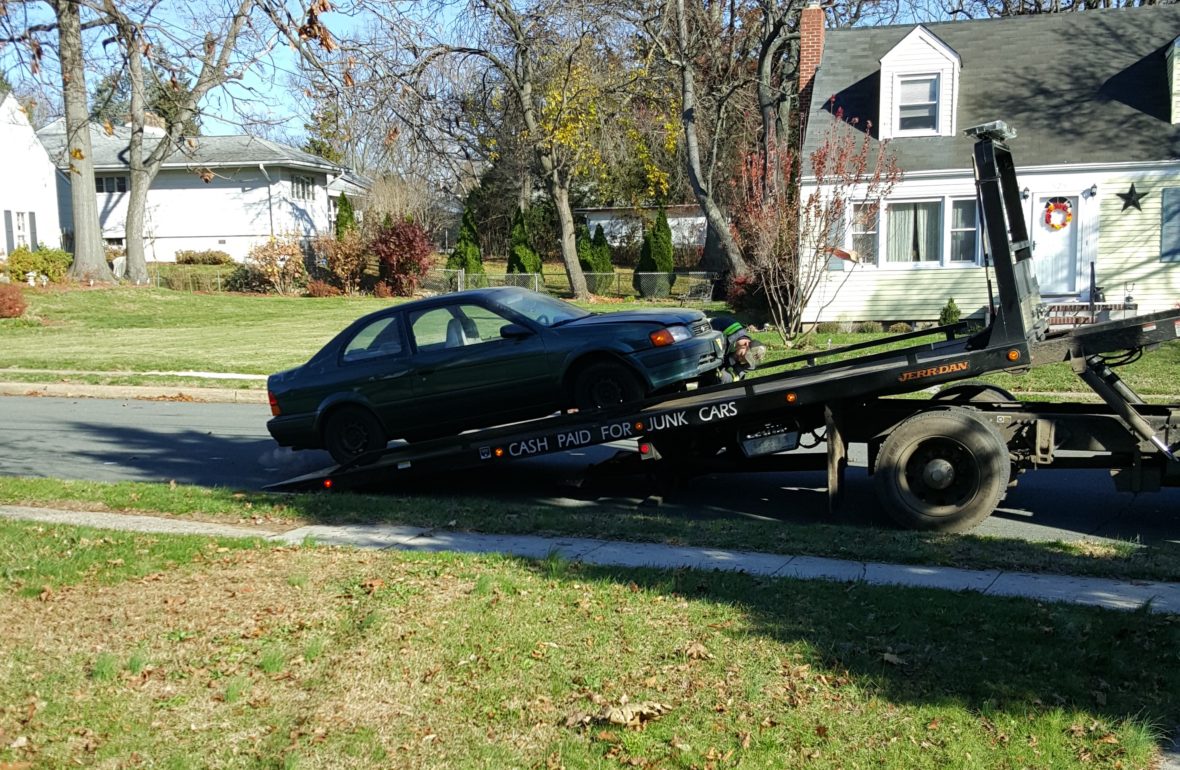
Wisdom said unto me, go thou forth and purchase a certified pre-owned luxury sedan, that ye might enjoy the performance and quality of German engineering (and learn to replace thine own driveshaft when thy sedan dost falter prematurely). ~Ancient Proverb
Most of us live in places where car ownership is a virtual requirement to running a life. This financial obligation might be avoidable for a while, but introduce some kids into the mix, or a job more than a few miles away and… you just plain need a car. Our friends and regular Wallet contributors Jaquan and Mikaela have done car ownership all sorts of ways, and today they are here to gift you (freely!) with a decade of wisdom on the topic. Pull out your steak knives and dine on this meaty goodness.
Jaquan: I went shopping for my first car right after I got a chemical engineering job fresh out of school. Despite having more money on my hands than I’d ever seen before, I thought I’d start off somewhat conservatively. Until I knew what I wanted, the thought was to get a reliable Japanese car whose value could be retained until I did finally figure out what I wanted. (So far soo good, amiright?) But I also had other priorities, such as wanting something that would handle well in the snow. So there I was looking at a reasonably priced Toyota Tacoma, and I happened to look up and see that there was an Audi dealership on the very same street. A quick look couldn’t hurt?
I had previously test driven a used A6 that was in someone else’s lot as a trade in, and was surprised to see how far the price had come down since that type of car depreciates so much once it’s bought (red flag!). That test drive had planted an idea in my head: what if I could find a performance vehicle that I could some day bequeath to my progeny – that we could work on and rebuild together (since my progeny were not on the horizon) the way those Old Gs used to do with a classic Mustang a generation ago? I LOVED the idea of having a car that could become a family heirloom, a hobby and a daily source of fun. This V6, standard transmission, Quattro, 2.8L pre-owned luxury sedan was my shot at realizing that dream. While this car would end up a thorn in my financial side, at the time my priorities seemed so noble:
- Developing the skills to fix my own car, given some resources that I had in my uncle and others.
- Performance: I also spent a lot of time in my car with my daily commute and frequent trips to visit family out of state (in the frozen tundra of upstate NY), so I wanted a ride I would enjoy (and enjoy in the snow).
Sounds level-headed, yeah? But wait – I was spending more on this sweet ride than I was on housing! (THIS IS ALWAYS A BAD SIGN.) Mind you, as a bachelor, I would rent rooms in people’s houses and was otherwise a bastion of good financial choices. But that car… it was my splurge. Excusable, right? It all worked out great, at first…
Mikaela: Jaquan loved that car. So, when we got married, we shared the car, but now we needed our own place to live as well. At the time I was volunteering as a project coordinator for a nonprofit, so we doubled our housing costs while our income stayed flat. We had a budget and did a great job handling all of our expenses, and contributing to our 401k, but other than that, savings were not happening. Meanwhile, just as I was getting used to driving the German Beauty, the car became possessed. Like, it needed an exorcism. It would shake and shimmy, confounding all the dealerships that we took it to. Finally, one dealer threw his hands up and encouraged us take the vehicle to a used car lot at night and pray that they’d pay us the $9k Kelly Blue Book value of the vehicle. But we still owed $11k on it! This was the very worst. We had an anchoring asset on our hands, and it felt awful.
Jaquan: Neither dealers, a mechanic shop, or a transmission company could identify the problem. The next step would have been a multi-thousand dollar repair that no one could guarantee would actually fix the issue. Auf wiedersehen German Beauty. It was painful but necessary.
We decided to get out of being upside down in our car payments by signing up for a lease (mistake number two). In our youthful optimism, we reasoned that since we now lived in the town where I worked, a lease would allow us to make monthly payments for three years and have a new car, rather than two years of payments with nothing. You see how we made this decision based on the lingering singe marks from our previous experience of being burned?
So we made a second list of priorities this time around, which led us to lease a brand new Honda Pilot:
- Hey! No more unknown repair risks!
- A definite timeline (3 years) during which we’d save up and get out of car debt permanently.
- Still need a vehicle that’s good in the snow. And comfortable!
That lease idea played out as you might expect. We spent a lot of time on the road despite only living a few miles from work because our weekends were spent with family living several hours away, traveling to weddings, or visiting friends out of state. At some point we made a spreadsheet to track our projected mileage and saw that we were going to be over by quite a bit (hefty $$ penalties!!) unless we staged an intervention. In this case, that meant another car, just to prevent us from incurring those mileage charges.
Welcome to our THIRD run at this in 3 years! We decided that the next phase of our car buying experience would prioritize:
- Purchasing a reliable brand
- Still being willing to do repair work myself
- Not having any car payments (woohoo!)
In this phase, we bought a ‘94 Toyota Camry that was a pretty nice car back in its day. It took the brunt of our mileage, essentially becoming our primary car while we only used the leased car occasionally. We did spend a lot of time on minor repairs which saved money, despite investing in more tools. I definitely learned a lot and it was a valuable experience for me. After the lease expired and we needed a second car I doubled down on the “old beater” car perspective and bought a ‘95 Toyota Tercel for $1,500 bucks. The benefit of a car that old is that at most you lose $1,500 bucks, plus repairs.
Mikaela: Car repairs took up a lot of Jaquan’s time during this phase, but it became this cool community-hobby. Friends would come by to help work on the car, and some even started bringing their cars over for oil changes. We accumulated a nice collection of tools for long-term maintenance too. But I have to tell y’all, this car was a hooptie. When we bought it, it smelled like some kind of animal pee. We literally paid to have it detailed to try to get the smell out. I guarantee the detailers had never shampooed such an old model. The passenger side window crank (manual, of course) would fall off occasionally… And there was body rust….oh the rust! Nevertheless, we were riding around debt free (a first in our automotive life) which felt great!
Next, we bought a used minivan to haul our kids and their stuff around. I got to try out some nifty negotiating skills I picked up in grad school to drive the price down, and we were able to pay cash. With little ones, it was important that the car be kept in good driving order, so we budgeted for routine maintenance at the dealer, where they also offered a loaner “swagger wagon”. (Note that negotiating also comes in handy with your dealers– try to get them to match the pricing of a local mechanic shop on major repairs!) As for the Camry– she kept on running, and we eventually gave it to a family member going off to graduate school! (Side note: in this phase of car ownership we found ourselves accumulating more capital in 4 buckets: Community, New Skills, Generosity… and Net worth!)
Jaquan: I grew to love that little Tercel, but eventually it died. With our third child on the way, we started to investigate buying a new car. In this phase, one of the trade-offs I was eager to make was gaining time with my children. Thanks to my commute I only had about two hours a day with them after work, before bedtime. That meant if I worked on my car for two hours each day, I wouldn’t see my kids all week. With kid # 3 on the way, we decided to buy a basic, new, Japanese car and budget for mechanic shop maintenance. At that point, we’d saved enough to be able to pay the new car off in full within a year. (Full disclosure: new cars cost money to maintain too. It’s been more robust that our old cars, but it’s definitely gone in for repairs more often than we’d like, so budgeting for maintenance is key here.)
Mikaela: As the years rolled by and we started having kids, the amount of time we could spend on car repair began to shrink. We saved up and bought a used minivan, but we budgeted for using the dealers for extensive repairs to leverage the convenience of their loaner cars and courtesy drivers. And that takes us to today.
So that’s our long, grizzly story. Having gone through all that… here’s our advice:
- Know your priorities and the reason behind your decisions. Abraham did not expect his decisions to jive with the cultural norms of his neighbors. Similarly, you should EXPECT to make decisions contrary to other people’s norms.
- Shift priorities as your circumstances change. When you’re young, single and broke, you have time to change your own brake pads. Once accruing finances stops being the number one priority, you should feel great about trading some of your money for more time with your family!
- Buy a car designed to meet your needs. My first car was designed for performance rather than robustness. So it was a very nice car, but it became irreparable before we paid off our payments.
- Understand the risks and benefits of your decisions. Jaquan knew how to deal with risks (like breakdowns and maintenance) becoming reality. If you can’t tolerate risks being realized, then you may want to ensure you minimize your risk. Gambles and risks can hurt more when you’re still getting established financially.
- Allocate your time with eyes wide open. Spending an extra two hours at my occupation would not yield significant increases in income, but spending an extra couple hours a day on car maintenance or house repair did yield some financial benefit. Spending an extra two hours a day with my kids had no financial benefit, but those two hours a day was 100% of my daily time allotment with them for the week, so if I gave that up I would not see them for any real amount of time during the week. It’s easy to get more money and very hard to get more time.
- Recognize that you are not your car. I (Mikaela) grew up subconsciously finding some identity in the type of car my family drove. On the small island where we lived, our class and status were implied by the way we spoke, the clothes we wore, and our car. Here in the U.S. I quickly realized that the abundance of credit meant you could drive an amazing brand new car, but be completely broke! Still, it took a lot of pride swallowing to get over this mental hurdle and drive an older car. I remember being nervous the first time I gave my then-boss a ride in my old Camry. I gave him my spiel about wanting to save money and buying only what I could afford to pay for in cash. Turns out he was impressed with my financial savvy!
And that’s it family builders. So tell us, what vehicular decisions have you made in your lives? How are those working out for you? Take it to the comments.






